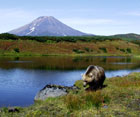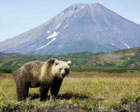
Biscuit and Chico

Biscuit at Hidden Lake

Biscuit near the Volcano
Two photos of Biscuit looking very adult
taken on a day trip to Kambalnoye Lake in
late Sept. 2000.
(Click on any Image to see a higher resolution version)
I wrote my last entry on the jet between Moscow and Petropavlovsk. As much as I like Moscow, there were things I wanted to do before I went home and Canada was calling too. Maureen stayed in Moscow to the end of September which was when her exhibition was being taken down at the new Art Center. I will admit that I was envious of what was yet in store for her there because the Canadian Ambassador, Rodney Irwin put on a black tie gala banquet for her at the embassy, an old palace, and had invited 25 important leaders of the art and environment communities. They then served up umpteen courses of delicious Canadian style foods washed down with Newfoundland's blueberry wine. The wonderful thing was that she had the best opportunity yet to talk to important people about her artwork and our work in Russia.
It has been our plan from the onset of this project that we would use our respective skills to spread the word about how great bears can be if they are treated kindly for a change. I have some catching up to do in this department considering Maureen's performance in Moscow. It was her exhibition and the attention that it drew that got our names and faces introduced everywhere. People all over that huge country live to some extent with bears and their lives are influenced in some way, both negatively and positively by them so they were automatically interested in our odd approach. Both Maureen and I were amazed at how many people back in Kamchatka suddenly started speaking of our project as theirs. After years of struggling to have our work accepted there, we were amazed at how this event had switched things around and now they were wanting to share ownership of our work. Wow! Now Maureen is talking about taking her exhibition into northern Europe, perhaps Finland, Denmark or Germany in 2001.
I think I have confessed before on the web, that I have felt a bit overwhelmed about keeping up my end of the bargain of having to tell this story in a literary way that would be equivalent to what Maureen has done so well with her artistic skills and her ability to talk to people about her concepts. Each year, the story keeps growing and getting so far ahead of me that I have struggled to catch up with it. But now I have some help from a friend who shares the dubious distinction of being born in the same prairie/foothills town of Pincher Creek, Alberta. Fred Stensen is a highly skilled editor as well as writer and has been helping me get my manuscript reorganized. Last week, I made a deal with Random House for Canadian and World distribution. Additionally, Fred was just nominated for Canada's top literary award, the Giller Prize for his new novel The Trade, so we are both flying high.
When I got back to Petropavlovsk on September 23rd the weather was beautifully clear and calm. I arrived on a Saturday and would fly to Canada on Monday which left Sunday open. Despite my jet lag from traveling almost halfway around the world over the vastness of a single country, I decided I wanted to get in my own little plane the next morning and fly down to Kambalnoy Lake to see if Chico was back from her trip. My Kolb had not yet been dismantled for the winter. I knew I had a problem with my battery which was three years old and worn out and had just managed to get me back to the city three weeks before. The battery powers the electric start but the engine does not rely on it for fuel ignition. I decided that if I could hand prop the motor to life in the morning when there was frost on the grass I would go because that would mean that I could get it restarted in warmer conditions at will. I wouldn't have time to go if I had to buy a new battery and install it before leaving.
I got to the cow pasture/aerodrome at 9 a.m. and there was lots of frost and as I predicted I had no problem starting the engine by swinging the prop by hand. I did, however, cut two of my fingertips on the very sharp stainless steel tape that protects the leading edge of the propeller. It had come unstuck enough to slice into them as my hand slid off the blade on the down stroke. My friends at the flying school bandaged them quickly with some gauze but by the time I had stuffed all my emergency gear into the plane the cockpit looked like the killing floor of an abattoir. Also predictable, the slippery wet grass allowed me to take off on the slick surface of my float.
I won't belabor a description of the flight except to say that the 250 km of mountains were at the height of fall color splendour. When I got down to the end of the peninsula the bears had moved back into our valley in great numbers and were eating pine nuts. I looked over many of them from the air and landed twice on small lakes thinking that I had spotted Chico but neither of them were her. By now I had remove the stainless steel tape and was getting good at manual starts. Finally I landed at our cabin to get some gas that I had stashed there and a spare camera body I had tucked away and forgotten to pack when we left. I knew it would be ruined by dampness during the winter now that there was no fire each day to dry things out. Nearing the time I had set myself to leave in order to get back to the Petropavlovsk by dark, I still had not seen either of our bears, but when I was getting ready to flip the propeller and go Biscuit wandered out of the bush all bleary eyed from a long nap. As you can see by the photos, she sure looked great and had put on a hundred pounds or more of weight. I went with her for a short walk still hoping to see Chico who surely could have been there somewhere among all the bears. Eventually I had to go without seeing her.
It was another great year in our quest to understand Ursus arctos horribilus and opportunities to talk to people about what we are learning that could suggest that grizzlies are not horrible at all if offered some understanding. We have both been very nearly twice around the world this year and the positive response to our work is growing. I feel good that people are looking closer at what we are doing and realizing that the images and stories they get from us are not suggesting that we are advocating others behave likewise. Most are finally seeing our demonstration for what it is - something possible under carefully thought out circumstances in a very out of the way place. I hope it is a study that people can dissect and take from it any bits and pieces that might be useful for their particular needs and circumstances. It has to be a slow process because evolution is slow when you are dealing with entrenched ideas and fear.
There are some good things happening in bear management circles. In particular the non-lethal bear management techniques that are being adopted in many places with black bears. This idea was promoted by Steve Searles and the number of black bears not being killed in situations where they once were, is remarkable -- www.bearaffairs.com. I personally hope that managers will eventually be able to take the next step beyond what they are doing with the "non-lethal" concept. These ideas are certainly very much better than any bear has endured in eons. But I fantasize that there will be a "next step" where people relax a few more notches, perhaps enough to be students of the bears themselves. Then maybe we will be able to replace the need to DOMINATE bears with an understanding that would allow people to share the land with them. This might only be my pipe dream but I am convinced that if it does not happen it is not the bears fault. It is a simple matter of how high we want to put our own sights as a species. We keep insisting that we are the most intelligent animal in the world. If this is true then lets some day prove it by dropping the inevitable excuse that what I am suggesting here is too much of a conceptual leap for the average person to grasp.
As for our future in Russia -- it is just a matter of once again finding enough money to get back for our sixth year. Every year has been more interesting than the last and I see this trend continuing for a few years yet. Especially with the prospect for Chico and Biscuit having their own cubs. Each year of our exploration might help our many sceptics to realize that brown bears, of any age, have a predictable capacity to respond with kindness if that is what they receive from humans. They too can be dominated, but probably not to the same extent black bears can be. Their potential to actually like people, and the implications of this, is something that fear of this animal has never allowed managers to consider exploring.
I feel sometimes that I have let Biscuit and especially Chico down in their wanting to take their demonstrations of trust much farther than even I feel comfortable with. Many times I will be sitting near Chico and she will wander up to me. Invariable I will push her away and stand up indicating to her that there is a limit to the vulnerability that I will place myself. I can see that this is a big disappointment to her. It's as though she keeps asking " Have I ever hurt you?" The truth is that she has not since she was about 20 lbs. when she was still unaware of her power. As they have grown to adults they seem to be increasingly aware and careful with their strength. This is not surprising when one considers how careful they must have to be with their new born cubs that enter the world weighing about one pound each. With a project like this one it takes a lot of careful judgement to stay out of trouble. Maureen disagrees, but I see myself still dominated by fear and it gets in my way of learning. I guess everything is relative.
- Charlie